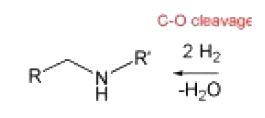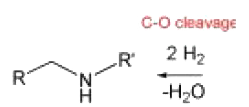Consider the following statements.
Carboxylation of RuBP is catalysed by RuBisCO.
The first stable intermediate compound formed is phosphoglycerate.
18 ATP molecules are synthesised during dark cycle.
NADPH+H+ is used to reduce diphosphoglycerate
Choose the correct option.
II,III and IV
I,III and IV
I,II and IV
I,II and III
The correct Answer is:C
To analyze the statements given in the question, we will evaluate each statement one by one:
1. Carboxylation of RuBP is catalyzed by RuBisCO.
- This statement is correct. The enzyme RuBisCO (Ribulose bisphosphate carboxylase/oxygenase) catalyzes the carboxylation reaction where carbon dioxide is fixed to ribulose bisphosphate (RuBP) to form 3-phosphoglycerate (3-PGA).
2. The first stable intermediate compound formed is phosphoglycerate.
- This statement is also correct. The product of the carboxylation of RuBP is 3-phosphoglycerate (PGA), which is indeed the first stable intermediate formed in the Calvin cycle.
3. 18 ATP molecules are synthesized during the dark cycle.
- This statement is incorrect. During the dark reactions (Calvin cycle), ATP is consumed rather than synthesized. ATP is produced during the light-dependent reactions, not in the dark cycle.
4. NADPH+H+ is used to reduce diphosphoglycerate.
- This statement is correct. NADPH is used to reduce 1,3-bisphosphoglycerate (not diphosphoglycerate) to glyceraldehyde-3-phosphate (G3P) in the Calvin cycle.
Now, summarizing the correctness of each statement:
- Statement 1: Correct
- Statement 2: Correct
- Statement 3: Incorrect
- Statement 4: Correct
Based on this analysis, the correct options are statements 1, 2, and 4.
Final Answer:
The correct statements are:
1. Carboxylation of RuBP is catalyzed by RuBisCO. (Correct)
2. The first stable intermediate compound formed is phosphoglycerate. (Correct)
3. 18 ATP molecules are synthesized during dark cycle. (Incorrect)
4. NADPH+H+ is used to reduce diphosphoglycerate. (Correct)
Thus, the correct option includes statements 1, 2, and 4.
- This statement is correct. The enzyme RuBisCO (Ribulose bisphosphate carboxylase/oxygenase) catalyzes the carboxylation reaction where carbon dioxide is fixed to ribulose bisphosphate (RuBP) to form 3-phosphoglycerate (3-PGA).
- This statement is also correct. The product of the carboxylation of RuBP is 3-phosphoglycerate (PGA), which is indeed the first stable intermediate formed in the Calvin cycle.
- This statement is incorrect. During the dark reactions (Calvin cycle), ATP is consumed rather than synthesized. ATP is produced during the light-dependent reactions, not in the dark cycle.
- This statement is correct. NADPH is used to reduce 1,3-bisphosphoglycerate (not diphosphoglycerate) to glyceraldehyde-3-phosphate (G3P) in the Calvin cycle.
- Statement 1: Correct
- Statement 2: Correct
- Statement 3: Incorrect
- Statement 4: Correct
The correct statements are:
1. Carboxylation of RuBP is catalyzed by RuBisCO. (Correct)
2. The first stable intermediate compound formed is phosphoglycerate. (Correct)
3. 18 ATP molecules are synthesized during dark cycle. (Incorrect)
4. NADPH+H+ is used to reduce diphosphoglycerate. (Correct)
Topper's Solved these Questions
Similar Questions
Consider the following statements.
Niteiles are hydrolysed to amides and then to acids in the presence of H+ or OH− as catalyst
Mild reaction condition are used to stop the reaction at the amide stage during the hydrolysis of nitriles.
Grignard reagents react with dry ice to from salts of carboxylic acids which in turn give corresponding carboxylic acids after acidification with mineral acid.
Select the correct option.View SolutionConsider the following statements and select the correct option stating which one is true(T) and which one is false (F)
i) Vemalisation can help in shortening the juvenile or vegetative period of plant and bring early flowering
ii) Phytochrome is a pigment protein complex which exists in two inter-convertible forms -Pr and P
iii) Sugar beet flowers after getting the inductive cycle of long dark periods and short photoperiods
iv) 2,4-D acts as weedicide to remove broad leaved weeds.
V) Auxins promote growth of lateral buds whereas cytokinins inhibit itView Solution
Knowledge Check
- Question 1 - Select One
Consider the following statements with respect to photosynthesis (A) The first carbon dioxide acceptor in C4 cycle is PGA
(B) In C3 plants, the first stable product of photosynthesis during dark reaction is RuBP
(C) Cyclic photophophorylation results in the formation of ATP
(D) Oxygen which is liberated during photosynthesis comes from waterAA and B alone are correct.BA and C alone are correct.CC and D alone are correct.DB and C alone are correct. - Question 2 - Select One
Consider the following statements with respect to photosynthesis (A) The first carbon dioxide acceptor in C4 cycle is PGA
(B) In C3 plants, the first stable product of photosynthesis during dark reaction is RuBP
(C) Cyclic photophophorylation results in the formation of ATP
(D) Oxygen which is liberated during photosynthesis comes from waterAA and B alone are correctBA and C alone are correctCC and D alone are correctDB and C alone are correct - Question 3 - Select One
Read the following statements regarding Calvin cycle.
CO2 is assimilated into sugars.
RuBP is regenerated.
ATP and NADPH are found.
Select the correct option.AI and IIBII and IIICI and IIIDAll of these
Consider the following statements regarding photosynthesis
(A) ATP formation during photosynthesis is temed as photophosphorylation
(B) Kranz anatomy pertains to leaf
(C) Reduction of NADP+ to NADPH occurs during Calvin cycle
(D) In a chlorophyll molecule mangesium is present in phytol tailView SolutionRead the passage given below and answer the following questions:
Reduction of carboxylic acids and their derivatives plays an important role in organic synthesis, in both laboratory and industrial processes. Traditionally, the reduction is performed using stochiometric amounts of hydride reagents, generating stochiometric amounts of waste. A much more attractive, atom-economical approach is a catalytic reaction using H2, however, hydrogenation of carboxylic acid derivatives under mild conditions is a very challenging task, with amides presenting the highest challenge among all classes of carbonyl compounds. Very few examples of the important hydrogenation of amides to amines, in which the C-O bond is cleaved with the liberation of water (Scheme 1), were reported. C-O cleavage of amides can also be affected with silanes as reducing agents.

We have now prepared the new, dearomatized, bipyridine-based pincer complex 3, catalyst 3(Here refered as Cat. 3). Remarkably, it efficiently catalyzes the selective hydrogenation of amides to form amines and alcohols (eq 1). The reaction proceeds under mild pressure and neutral conditions, with no additives being required. Since the reaction proceeds well under anhydrous conditions, hydrolytic cleavage of the amide is not involved in this process.

(Balaraman, E., Gnanaprakasam, B., Shimon, L. J., & Milstein, D. (2010). Direct hydrogenation of amides to alcohols and amines under mild conditions. Journal of the American Chemical Society, 132(47), 16756-16758.)
In the following questions, a statement of assertion followed by a statement of reason is given. Choose the correct answer out of the following choices on the basis of the above passage.
Assertion: The use of catalyst 3 is an efficient method of preparation of primary amines
Reason: Use of catalyst 3 is a step down reaction.View SolutionRead the passage given below and answer the following questions:
Reduction of carboxylic acids and their derivatives plays an important role in organic synthesis, in both laboratory and industrial processes. Traditionally, the reduction is performed using stochiometric amounts of hydride reagents, generating stochiometric amounts of waste. A much more attractive, atom-economical approach is a catalytic reaction using H2, however, hydrogenation of carboxylic acid derivatives under mild conditions is a very challenging task, with amides presenting the highest challenge among all classes of carbonyl compounds. Very few examples of the important hydrogenation of amides to amines, in which the C-O bond is cleaved with the liberation of water (Scheme 1), were reported. C-O cleavage of amides can also be affected with silanes as reducing agents.

We have now prepared the new, dearomatized, bipyridine-based pincer complex 3, catalyst 3(Here refered as Cat. 3). Remarkably, it efficiently catalyzes the selective hydrogenation of amides to form amines and alcohols (eq 1). The reaction proceeds under mild pressure and neutral conditions, with no additives being required. Since the reaction proceeds well under anhydrous conditions, hydrolytic cleavage of the amide is not involved in this process.

(Balaraman, E., Gnanaprakasam, B., Shimon, L. J., & Milstein, D. (2010). Direct hydrogenation of amides to alcohols and amines under mild conditions. Journal of the American Chemical Society, 132(47), 16756-16758.)
In the following questions, a statement of assertion followed by a statement of reason is given. Choose the correct answer out of the following choices on the basis of the above passage.
Assertion: Aniline can be prepared from suitable amide using catalyst 3
Reason: The use of catalyst 3 is limited to aliphatic amides only.View SolutionRead the passage given below and answer the following questions:
Reduction of carboxylic acids and their derivatives plays an important role in organic synthesis, in both laboratory and industrial processes. Traditionally, the reduction is performed using stochiometric amounts of hydride reagents, generating stochiometric amounts of waste. A much more attractive, atom-economical approach is a catalytic reaction using H2, however, hydrogenation of carboxylic acid derivatives under mild conditions is a very challenging task, with amides presenting the highest challenge among all classes of carbonyl compounds. Very few examples of the important hydrogenation of amides to amines, in which the C-O bond is cleaved with the liberation of water (Scheme 1), were reported. C-O cleavage of amides can also be affected with silanes as reducing agents.

We have now prepared the new, dearomatized, bipyridine-based pincer complex 3, catalyst 3(Here refered as Cat. 3). Remarkably, it efficiently catalyzes the selective hydrogenation of amides to form amines and alcohols (eq 1). The reaction proceeds under mild pressure and neutral conditions, with no additives being required. Since the reaction proceeds well under anhydrous conditions, hydrolytic cleavage of the amide is not involved in this process.

(Balaraman, E., Gnanaprakasam, B., Shimon, L. J., & Milstein, D. (2010). Direct hydrogenation of amides to alcohols and amines under mild conditions. Journal of the American Chemical Society, 132(47), 16756-16758.)
In the following questions, a statement of assertion followed by a statement of reason is given. Choose the correct answer out of the following choices on the basis of the above passage.
Assertion: Use of hydride catalyst or hydrogen brings about cleavage of C-O bond in amides.
Reason: Hydride catalyst or hydrogen cause to reduction of amides.View SolutionRead the passage given below and answer the following questions:
Reduction of carboxylic acids and their derivatives plays an important role in organic synthesis, in both laboratory and industrial processes. Traditionally, the reduction is performed using stochiometric amounts of hydride reagents, generating stochiometric amounts of waste. A much more attractive, atom-economical approach is a catalytic reaction using H2, however, hydrogenation of carboxylic acid derivatives under mild conditions is a very challenging task, with amides presenting the highest challenge among all classes of carbonyl compounds. Very few examples of the important hydrogenation of amides to amines, in which the C-O bond is cleaved with the liberation of water (Scheme 1), were reported. C-O cleavage of amides can also be affected with silanes as reducing agents.

We have now prepared the new, dearomatized, bipyridine-based pincer complex 3, catalyst 3(Here refered as Cat. 3). Remarkably, it efficiently catalyzes the selective hydrogenation of amides to form amines and alcohols (eq 1). The reaction proceeds under mild pressure and neutral conditions, with no additives being required. Since the reaction proceeds well under anhydrous conditions, hydrolytic cleavage of the amide is not involved in this process.

(Balaraman, E., Gnanaprakasam, B., Shimon, L. J., & Milstein, D. (2010). Direct hydrogenation of amides to alcohols and amines under mild conditions. Journal of the American Chemical Society, 132(47), 16756-16758.)
In the following questions, a statement of assertion followed by a statement of reason is given. Choose the correct answer out of the following choices on the basis of the above passage.
Assertion: N-methyl ethanamide on reaction with catalyst 3 will yield ethanol and methanamine.
Reason: Use of Catalyst 3 brings about cleavage of C-N bond of amidesView Solution

